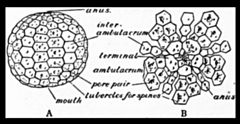Project 4566: J. R. Thompson, L. J. Cotton, Y. Candela, M. Kutscher, M. Reich, D. J. Bottjer. 2021. The Ordovician diversification of sea urchins: systematics of the Bothriocidaroida (Echinodermata: Echinoidea). Journal of Systematic Palaeontology. 19 (20):1395-1448.
Abstract
The echinoids of the order Bothriocidaroida represent the initial burst of sea urchin diversification. They were the first echinoids to achieve widespread biogeographical dispersal and achieved high levels of species richness compared to other clades of stem group echinoids. Following long-standing controversy regarding their phylogenetic affinities within the phylum Echinodermata, bothriocidaroids are now regarded as echinoids. The species- and genus-level phylogenetic relationships of the bothriocidaroids, are, however, less clearly known. We herein compile a database of bothriocidaroid occurrences, undertake detailed phylogenetic analyses of all named species within the Bothriocidaroida, and provide updated diagnoses for all species. Our phylogenetic analysis includes species belonging to three genera: Bothriocidaris, Unibothriocidaris and Neobothriocidaris. Furthermore, we describe a new species, Neobothriocidaris pentlandensis sp. nov., from the Silurian of Scotland and Sweden, using micro-computed tomography and scanning electron microscopy. This species has implications for understanding the diversity dynamics of bothriocidaroids before and after the Late Ordovician mass extinction and the palaeobiogeographical distribution of bothriocidaroids in the Silurian. Using Bayesian and parsimony-based phylogenetics, we demonstrate that Neobothriocidaris is a distinct clade, and depending upon the analytical technique, Unibothrioidaris and Bothriocidaris are also resolved as monophyletic. Unibothriocidaris appears to have become extinct in the Sandbian, while Neobothriocidaris and Bothriocidaris survived the Late Ordovician extinction events and lasted at least until the Ludlow. Furthermore, we performed statistical time-calibration of our phylogenetic trees and show that bothriocidaroids originated in the Dapingian or Darriwilian, diversifying in the Darriwilian to Sandbian and reaching peak diversity in the Sandbian and Katian. This Sandbian and Katian peak is similar to that observed in other echinoderm clades, as well as other animal groups during the Ordovician radiation, and may be linked to heightened sea level and expansive tropical shelves present in the Upper Ordovician, and to new inhabitable environments linked with Ordovician oxygenation.Read the article »
Article DOI: 10.1080/14772019.2022.2042408
Project DOI: 10.7934/P4566, http://dx.doi.org/10.7934/P4566
| This project contains |
|---|
Download Project SDD File |
Currently Viewing:
MorphoBank Project 4566
MorphoBank Project 4566
- Creation Date:
17 February 2023 - Publication Date:
17 February 2023
This research
supported by
Authors' Institutions ![]()
- Staatliches Naturhistorisches Museum, Braunschweig
- Natural History Museum, London
- National Museums of Scotland, Royal Museum, Edinburgh
- Ludwig-Maximilians-Universitaet Muenchen
- University College London
- University of Southern California
- Naturalis Biodiversity Center
- GeoBio-Center
Members
| member name | taxa |
specimens |
media |
| MorphoBank Curator Project Administrator | 3 | 1 | 1 |

